![]()
Creatine
Can you finally attain your beach body?
![]()
Prakshan Vasuthan, Arnold Cheng, Louis Kebell
Eton College, UK
![]()
Molecule of the Month November 2022
Also available: HTML version.
![]()
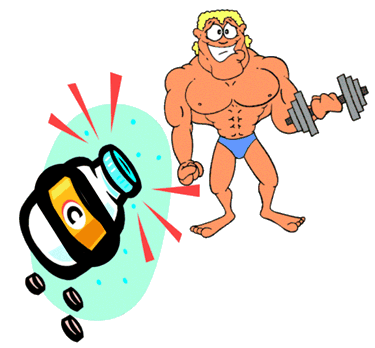
CreatineCan you finally attain your beach body?
Prakshan Vasuthan, Arnold Cheng, Louis Kebell
Molecule of the Month November 2022
|
 |
Creatine is a nitrogen-containing organic acid found within most vertebrates, which is used to build and maintain muscle tissue growth as well as to aid the synthesis of adenosine triphosphate (ATP, see MOTM for January 1998). Creatine comes under the umbrella of amino acids, and it is responsible not only for the increased growth of muscles but also the delayed onset of muscle fatigue. A gym rat’s dream! The compound, however, is extremely rare; an average human liver, pancreas and kidneys produce a mere gramme of creatine per day. 95% of the body’s creatine is stored in the skeletal muscle tissue and the other 5% in the brain to aid neuron energy metabolism. As a result of its elusive nature, scientists have looked to synthesise and mass produce the product to supplement athletes globally.
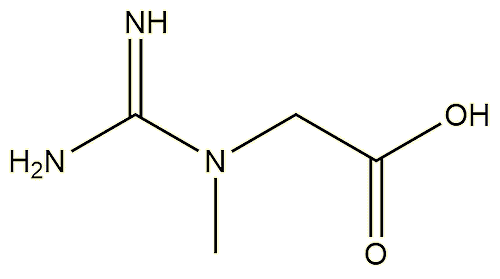 |
|
| Creatine |
No, although two of the protein-forming amino acids, glycine and arginine, are also used for the biosynthesis of creatine (see diagram below). There are several amino acids which have biochemical functions other than protein synthesis; another is gamma-aminobutyric acid (GABA; see MOTM July 2015).
Although creatine seems to have become a trendy craze in the fitness industry within the last few decades, its discovery can be traced back to 1832 – before the sport of bodybuilding was ever created. A French scientist, Michel Eugene Chevreul, isoated it from an ingredient of beef tissue. He named the molecule creatine from the Greek word kreas, meaning meat. From this, a German scientist, Justus von Liebig, found that creatine was present in other meats as well, and went on to measure the creatine levels amongst different types of wildlife. Through his studies, he found that wild animals had approximately ten-times higher concentrations of creatine in their flesh than domesticated animals. Therefore, von Liebig proposed that physical activity in day-to-day life might have an influence on the concentration of creatine in flesh. Moreover, (if any aspiring Mr Olympias are reading this article) it was discovered that doing physical activity itself creates creatine in the muscles. Von Liebig went on to discover that creatinine – a breakdown product of creatine – was found in urine.
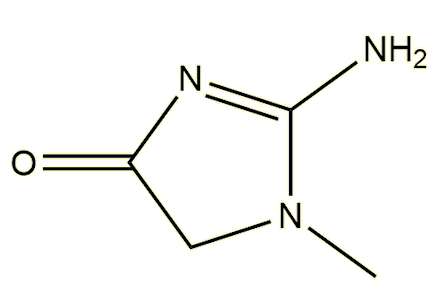 |
|
| Creatinine |
In 1912, at Harvard University, researchers found that the consumption of creatine produces a dramatic increase in the content of creatine within muscle tissue. Feeding creatine to animals promoted nitrogen retention. What this meant was that the protein was accumulating in the muscle.
In the 1920s, creatine was given to humans, and found to have an an anabolic effect, that is, it caused muscle to grow.
 That must have been an amazing find for athletes?
That must have been an amazing find for athletes?Not at first. Because the only source of creatine was from a difficult, costly and time-consuming extraction process from meat, creatine was expensive and in short supply. What was needed was a synthetic route to creatine...
Yes, although it took until the 1950s before synthetic creatine could be made cheaply in the lab. But once this was available, scientists all over the world started using it to study its effects upon muscles, both for increasing muscle growth but also for treating muscle atrophy in diseases such as Huntington’s, Parkinson’s or Muscular Dystrophy.
But most people first heard about creatine in the 1990s, when famous athletes such as Sally Gunnell and Linford Christie said they'd used creatine supplements, and these had helped them achieve better performances. By the time the Atlanta Olympics came around in 1996, it was believed that over 80% of the athletes were using creatine supplements.
 |
 |
| Sally Gunnell in 1995 [Image: User:Electric.tapirderivative work: Ukexpat, CC0, via Wikimedia Commons] |
Linford Christie |
Biologically, creatine synthesis usually takes place in the liver from two other amino acid, glycine and L-arginine using 2 enzymes code-named EC 2.1.4.1 and EC 2.1.1.2. Synthesis can also take place in the kidney and pancreas. After it is made, creatine is mainly stored within skeletal muscle and fast-twitch muscle fibres.

Biosynthesis of creatine
[Image: Akane700, CC BY-SA 3.0 via Wikimedia Commons
In the lab, creatine monohydrate for use in supplements is made from sarcosine and cyanamide, which are heated in a pressurised reactor with some catalyst compounds. The creatine crystals which result are the cntrifuged to remove any unwanted particles, vacuum dried, and then milled into a fine powder to allow it to dissolve better in water.

Lab synthesis of creatine
When looking at the effects of creatine, they appear to be every athlete’s dream. Consuming creatine supplements can result in boosted energy levels, enhanced strength, increased muscle mass, reduced tiredness, and even improved cognitive ability. This may make creatine seem like a mystical source of power, but the way creatine produces these results is very scientific. When creatine is in the body, it gets converted into phosphocreatine by an enzyme called creatine kinase. By reversing this process, ATP is made when the phosphocreatine turns back to creatine by transferring phosphate to adenosine diphosphate (ADP). Every time you use your muscles, whether it be to run, jump, or lift weights, energy is required, and this energy comes from ATP.

The creatine/ATP cycle
Consuming creatine results in the production of more phosphocreatine, which, in turn, produces more ATP. By providing the body with more energy, Creatine produces the mystical power mentioned earlier, as, suddenly, lifting weights becomes a little bit easier and less tiring. However, it is important to note that the short-term increase in muscle mass that creatine sometimes causes is not actual muscle growth. Instead, it is simply muscle cells taking in water as they absorb creatine, temporarily making muscles larger.
 What are the different forms of creatine supplements?
What are the different forms of creatine supplements?Creatine can be consumed in a wide variety of ways. It is available in tablets, capsules, and in powders that are used to make drinks. Creatine is also in most foods that contain a lot of protein, such as beef, pork, and salmon. However, these food sources contain typically less than 1% creatine. Also, creatine can be modified cheically for different applications.
Creatine ethyl ester is synthesised from creatine and ethanol. It was believed to make the creatine more bioavailable. However, this theory was disproved in 2009 in a comparative study between creatine ethyl ester and creatine monohydrate. There was no noticeable improvement in patients who used the ester form compared to those who took the monohydrate.
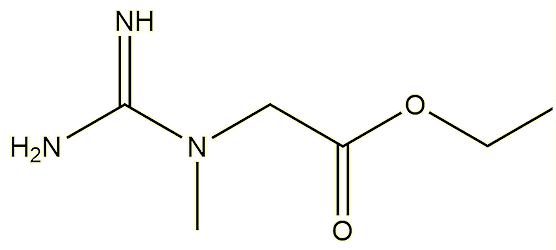 |
|
| Creatine ethyl ester |
Creatine hydrochloride is a more acidic creatine form matching that of the human stomach removing the risk of stomach cramps that some customers reported after taking creatine monohydrate. The hydrochloride is also reported to be absorbed more readily in the body and so recommended serving portions of creatine hydrochloride are under 1 gramme as opposed to the 5 gramme usual dosage of creatine monohydrate.
Buffered creatine includes an alkaline substance such as sodium carbonate or sodium bicarbonate and therefore has a high pH. The alkaline buffer of this supplement prevents creatine from prematurely breaking down into creatinine before it can be absorbed by the body.
 How accessible is creatine?
How accessible is creatine?Right is a picture of energy drinks that contain creatine. Anyone could walk into a store (such as Walmart in the US) and buy one of these cans, raising the question of whether creatine is too accessible. Critics of the lack of regulation of creatine often argue that a substance which can cause unhealthy side effects (such as muscle cramps, high blood pressure and liver dysfunction) should not be openly sold at such a large scale.
Yes, these include muscle cramps, pulled or strained muscles, upset stomach, diarrhea and dizziness. One of the most common side-effects of taking creatine supplementation is gaining weight, probably due to increased water retention. But generally creatine is considered to be safe for healthy humans to take, even for long periods (5 years), although it does have adverse effects with some common medical drugs, such as ibuprofen.
One alternative is beta-alanine which is also an amino acid found within vertebrates. This increases the body’s level of carnosine present in the body’s muscles, which once again delays the onset of muscle fatigue. As far as food is concerned, because all the listed protein supplements are naturally occurring molecules, they can easily be found in rich quantities in foods such as white fish, beef, pork and poultry. However, try to avoid the fat of these foods as it will not contain the desired products.
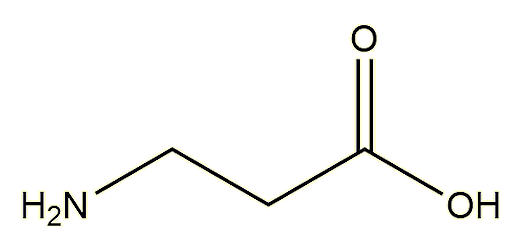 |
|
| Beta-alanine |
![]()
![]()
![]() Back to Molecule of the Month page. [DOI:10.6084/m9.figshare.21385137]
Back to Molecule of the Month page. [DOI:10.6084/m9.figshare.21385137]